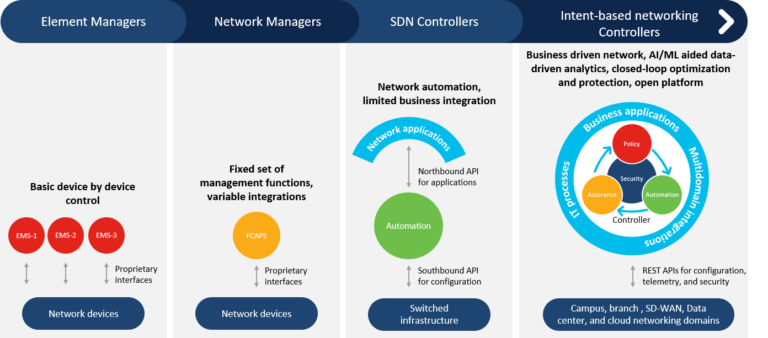































If you are struggling to manage your network and spending hours making sure all devices are configured properly, sifting through umpteen logs to identify the root cause of issues, and wondering why you don't have better tools, take heart.
Your network is important to you. After all, it's the network that determines in a large part the outcomes of your business initiatives. Whether you are seeking to optimize your business processes or improving customer experiences, you are likely to depend on your network. The network needs to scale, perform, ensure security, and most of all be agile to adapt to the inevitable, and sometimes rapid changes as your initiatives adjust to constantly shifting ground realities.
To meet these increasing demands brought on by more users, devices, things, applications and cloud, networks are getting more complex, and organizations are having a hard time managing them to meet their business needs. Often, they utilize multiple tools, manual CLI configurations, and troubleshoot by trying to recreate the problem and poring over logs. All this takes too long, is error prone, and ties up network engineers in low-value work.
This blog is the first in a series of blogs that explore several aspects of intent-based networking.
In response to these challenges, enterprise networks are evolving towards an intent-based networking model. Veering away from classical networks, where a lot of the day-to-day operations are manual, intent-based networks (IBN) automate the core functioning of the network. They take high-level business intent as input, translate it into network policies, configure network devices to execute on the policies, and monitor these devices to ensure that policies are being met. This set of functionality makes IBN ideal for realizing the benefits you envision from your digital transformation initiatives.
"While only 4% of IT leaders and network strategists classify their network as an intent-based network today, 35% plan for their network to be intent-based within two years."
-A key finding from Cisco 2020 Global Networking Trends Report
At the heart of an intent-based networking deployment sits the network controller. Network controllers epitomize the evolution of network management which has evolved from basic element managers to more capable network managers and SDN controllers. While the evolution to SDN controllers advanced software control, automation, and programmability, it was narrow in scope and custom made. Full network controllers, on the other hand, go beyond SDN controllers and help realize the complete vision of intent-based networking.

Network controllers provide the required policy, activation, assurance, security, and integration functions that are keys to an intent-based network implementation.
Policy: Controllers take business intent as input and translate it into network policies. For example, the intention to conduct a multiparty telepresence conference at 10 AM might be interpreted by the controller that it needs to set policies for the required bandwidth, QoS, and encryption in the wired and wireless campus and WAN networks.
Activation: Controllers activate the underlying network infrastructure formed by switches, routers, and wireless equipment, by generating required configurations and provisioning the devices according to the defined policy. In our example, the controller would configure network devices to provide the specified service levels.
Assurance: Controllers analyze network data to spot any issues that might be preventing the network from acting in accordance with policies. For example, the controller could detect the lack of video quality in a segment of the network, find the root cause, and provide the user with the fix they need to make.
Security: Controllers have complete visibility into the users, devices, things, and applications on the network. This puts them in a position to detect abnormal behavior or anomalies that could represent a threat. Controllers can take mitigating actions to secure the workplace, workloads, and workforce.
Integrations: Controller APIs enable programmatic two-way interaction between the network and external business & IT applications. These APIs also allow communications between controllers for synchronization towards fulfillment of shared business intents across multiple networks. For example, an external program may instruct the controller to set up devices for an important conference.
With its suite of functionality, controller-led architectures are becoming indispensable. Organizations are finding that they can substantially cut manual effort, reduce security vulnerabilities, lower their operational expenses, increase regulatory compliance, and make sure the network is constantly adapting, learning, and aligning with business needs.
"By 2025, 75% of networking teams will spend less than a third of their time maintaining the network status quo and two-thirds delivering innovation and creating value for the business."]
- Joe Clarke, Cisco Distinguished Engineer, Cisco 2020 Global Networking Trends Report
So, if you want more intelligent control that can help you focus not on your network but on your business, check out these controller-led architectures from Cisco:
Furthermore, Cisco's multidomain architecture integrates policy elements between these controllers so that it is enforced end-to-end for enterprise-wide consistency and results.
Next in our blog series we will dive deeper into more aspects of intent-based networking, including:
 Tags quentes :
Cisco ACI
#CiscoDNA
Cisco DNA
Cisco SD-WAN
#CiscoACI
intent-based networking (IBN)
#intentbasednetworking
#CiscoDNACenter
#CiscoSDWAN
Tags quentes :
Cisco ACI
#CiscoDNA
Cisco DNA
Cisco SD-WAN
#CiscoACI
intent-based networking (IBN)
#intentbasednetworking
#CiscoDNACenter
#CiscoSDWAN